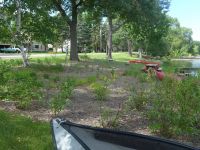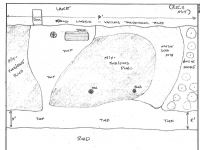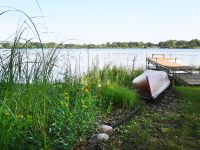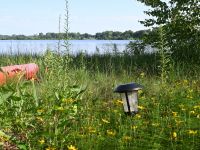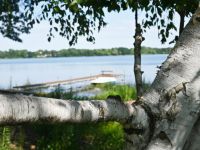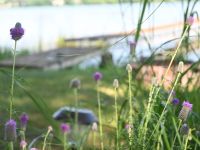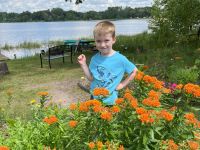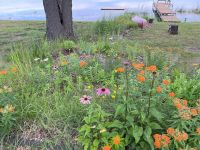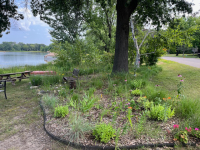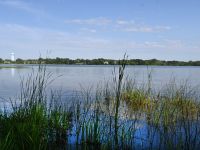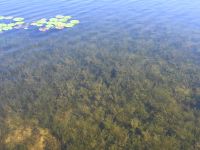Neighborhood Spotlight: Carol
Carol’s native shoreline restoration flourishes at the south side of Birch Lake in the City of White Bear Lake. The effort was completed by Lakeshore Technology over a decade ago, and is a testament to the long-term potential of shoreline and habitat restorations. The variety of plant species provides blooms form early spring to late fall, with a privacy screen provided by shrubs and trees. The extra touch of grasses and rushes blowing in the wind creates a relaxing and some would say therapeutic aesthetic. Carol and Keith applied for VLAWMO grant funding in two phases to support the project. Birch Lake is one of the cleanest lakes in the VLAWMO watershed, and is the cleanest lake that is fully surrounded by suburban development. This combination makes Birch Lake a unique VLAWMO is thankful for Carol and Keith’s dedication to support the lake’s health in this way, and to share their experience of learning and tending to their shoreline.
Shoreline chat with Carol
What motivated you to pursue this project?
We moved to South Birch Lake Blvd in WBL in 1984 when our oldest son was only 3 months old. The existing lakeshore on the south side of Birch Lake was pretty boring apart from the 2 beautiful oak trees and a birch tree. But it was mostly turf grass that didn’t grow well and a blend of weeds. Raising our 3 sons on the lake, we always had a dock. The boys loved playing in the lake, swimming, canoeing, fishing off the dock in the spring/summer/fall and skating and playing hockey in the winter. But the lakeshore was very bare an “eyesore” much of the year and we didn’t enjoy or spend any time on the shoreline itself.
I was on the City of WBL environmental commission in 2010 when we became interested in improving our shoreline. I attended a VLAWMO workshop on raingardens and shoreline “lakescaping” and became convinced that was the direction we wanted to go, and it helped to have the opportunity for a cost-sharing grant from VLAWMO!
Contracting with Natural Shore Technologies, a company that does native and prairie projects, we worked together to create a plan that blended with the two well-established oak trees and a young birch tree. The first phase of the project was completed in 2011. This area included native plants such as prairie drop seed, side-oats, and little blue stem grasses, spiderwort, Jacob’s Ladder, wild lupine, coreopsis, purple prairie clover, liatris, Coneflower, Rudbeckia (Black Eyed Susans), butterflyweed, columbine, allium, blue bells, aromatic asters, blue eyed grass, and others.
The following year we completed the project with the addition of shrubs on the east end, including red twig dogwood, high bush cranberry and dwarf bush honeysuckle, which gave us more privacy. Over the years we’ve added some other perennials, some which are native and some are not. As many of the original plants have reseeded themselves, the locations of many of the flowers have shifted over time, with each year being a bit different. Though not all plants have survived, the majority continue to grow and provide pollinators with flowers throughout spring, summer, and fall.
How does the project change your interactions with your yard and lake?
Since the “lakescaping,” I spend considerably more time on our lakeshore. Discovering which plants come up each spring, and watching them flower from spring to fall, is a pure delight. It’s a calming place for me where I interact with nature while weeding or checking on plants. Often I’ll look up and see a mother duck with her little ducklings swim by, an eagle overhead, birds perching on the reeds in the lake, an egret or heron landing on the shore, or a muskrat with plants in its mouth padding by. This year there were many toads!
It’s common to hear the birds chirping, woodpeckers pecking away in nearby trees, bees buzzing in the flowers and the wind shaking the leaves of the shrubs and trees. Even an occasional loon, green heron, sand hill crane, or bittern stops by. Our interest in birds has increased over this past decade, partly due to our shoreline restoration.
My grandkids, age 8 and under, enjoy the shoreline, exploring the different flowers and walking through the bushes and finding big toads! We sometimes do treasure hunts there.
Have there been any challenges along the way?
Challenges include weeds, drought, and tree roots.
Weeds: Since I love spending time there, I can keep up with the weeds and grasses that volunteer themselves in. Turf from the lawn area is making some headway in certain spots. Our yard has very sandy and shaded soil, so it hasn’t really filled out with dense native plants. It’s an alright balance for me, but not all shorelines have this dynamic.
Drought: The first year or two we watered the plantings but since then we only water when we don’t get rain for long periods of time. Unfortunately, we’ve had drought years several times. Most of the plants resist drought, but as shoreline species selected to be wet and dry near water, they really do thrive better when they get regular rains. This year, with the abundant rains, the plants are thriving.
Tree roots: An area under one of the big oak trees has been a challenge. No matter what I plant there, it doesn’t grow well. We think the tree roots and possibly very poor soil are contributors. But plants grow well on the rest of the lake shore.
Squirrels, moles and rabbits: These critters sometimes dig up or eat plants and roots. However, they are part of nature and deserve to inhabit the shoreline also! We’ve seen how the plants adapt by re-seeding and shifting around, similar to how a historic prairie functioned.
What have been your favorite parts or pleasant surprises?
It is a pleasant surprise every year when I discover which flowers are blooming. The yearly succession of flowers blooming is fun to follow. First the Jacob’s Ladder, then Lupine, followed by columbine, spiderwort, coreopsis, butterfly milkweed and so on until the asters in the fall.
The biggest moment of enjoyment comes in late summer when the liatris (rough blazing star) are blooming and the monarch butterflies congregate on them for several weeks, enjoying the flowers before flying on their journey. I’ve taken lots of videos and pictures, posting them on Facebook to share with others. Often I’ll count up to 20 butterflies fluttering among the flowers.
A walking/biking path is located between our home and the lake and many people walk by each day. When I’m in the area doing some work, people walking by often stop to comment on the beauty of our shoreline. They especially like the Monarch butterflies that are enjoying the flowers in late July!
Any advice for folks who may be interested in trying out a shoreline restoration or something similar?
- Unless you have a lot of knowledge about native plants, contract with a company that is experienced in native plantings.
- Check with VLAWMO to find out if cost sharing funds are available. If so, you will need to make your plan and submit it. (It’s an easy form to do); VLAWMO is a very friendly organization and they put on great educational workshops. Definitely attend one of VLAWMO’s workshops before starting a project like this.
- Keep up with the weeding. I have seen several areas around Birch Lake where native shoreline plantings were done but the weeds took over quickly.
- Spend time enjoying and observing your restoration!
- Recommended books: Bringing Nature Home by Doug Tallamy or The Regenerative Landscaper by Erik Ohlsen

